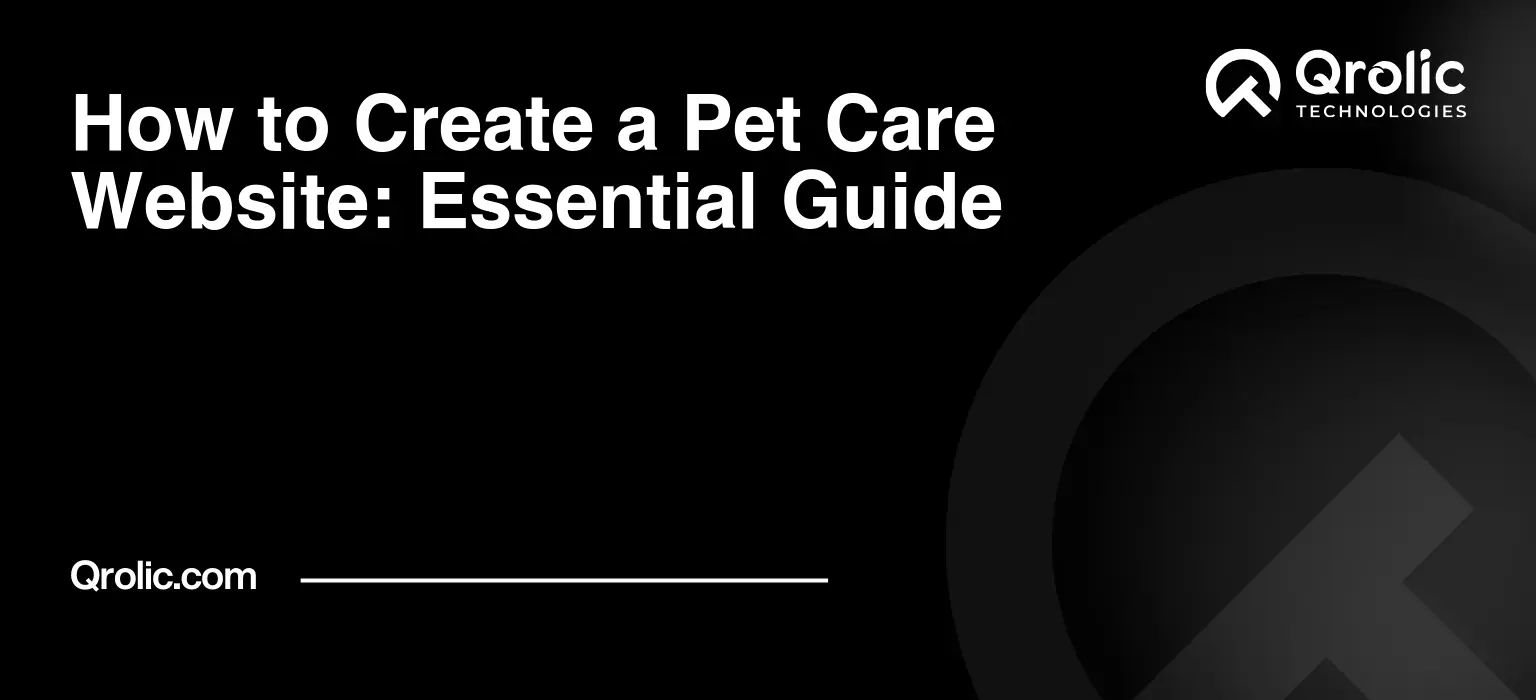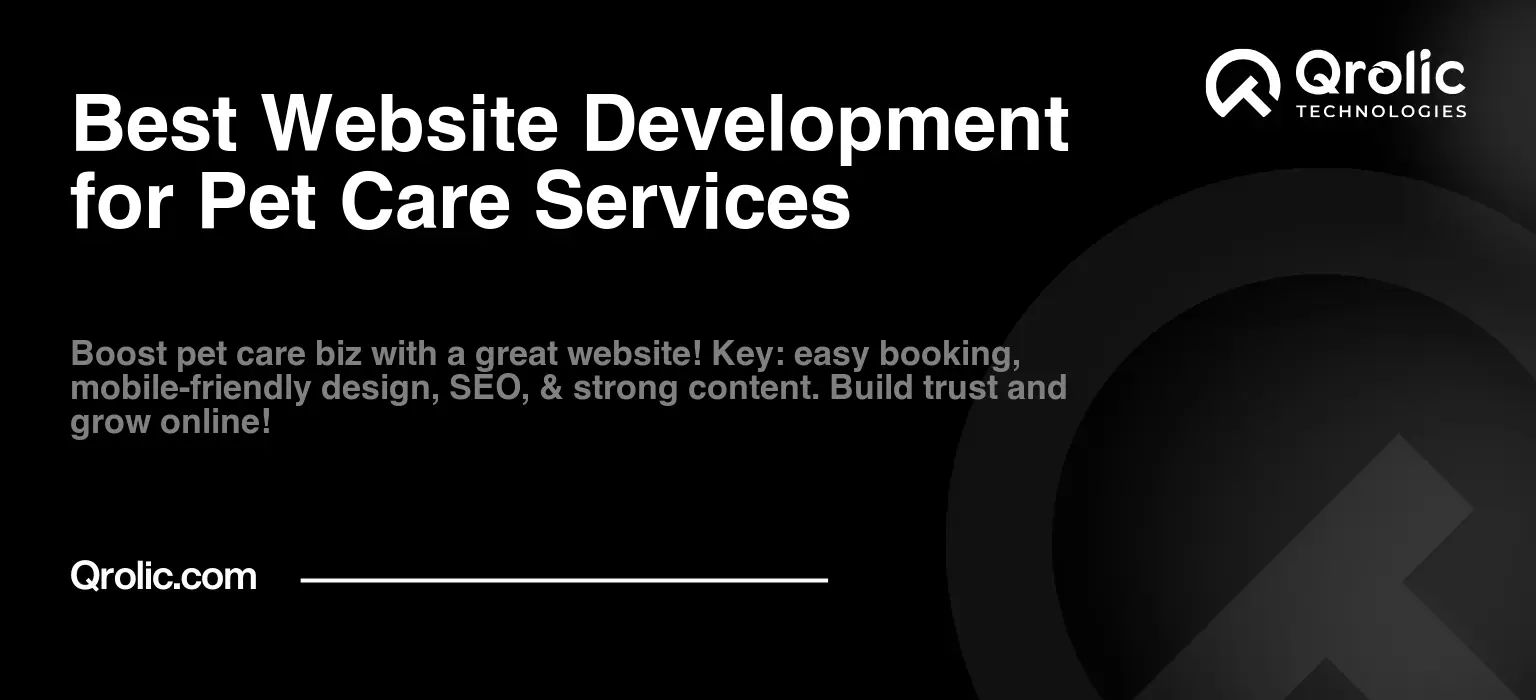Quick Summary:
- Plan your website, audience, and services.
- Design a mobile-friendly site with good visuals.
- Create helpful content and get found online.
- Promote your site and keep it updated.
Table of Contents
- Introduction: Why Your Pet Care Business Needs a Website
- I. Planning Your Pet Care Website: Laying the Foundation for Success
- 1. Defining Your Target Audience: Who Are You Trying to Reach?
- 2. Identifying Your Core Services: What Do You Offer?
- 3. Setting Goals for Your Website: What Do You Want to Achieve?
- 4. Analyzing Competitor Websites: What Are They Doing Well (and Not So Well)?
- II. Designing Your Pet Care Website: Creating a User-Friendly and Visually Appealing Experience
- 1. Choosing a Domain Name and Web Hosting: Establishing Your Online Identity
- 2. Selecting a Website Platform: WordPress, Wix, or Other Options?
- 3. Choosing a Theme or Template: Creating a Visually Appealing Design
- 4. Designing a User-Friendly Navigation: Making it Easy for Visitors to Find What They Need
- 5. Optimizing for Mobile Devices: Reaching Customers on the Go
- 6. Incorporating High-Quality Images and Videos: Showcasing Your Services
- 7. Creating a Consistent Brand Identity: Building Recognition and Trust
- III. Creating Compelling Content for Your Pet Care Website: Engaging and Informing Your Audience
- 1. Writing Engaging and Informative Service Descriptions: Highlighting the Benefits
- 2. Creating a Blog: Establishing Authority and Sharing Valuable Information
- 3. Adding Testimonials and Reviews: Building Trust and Credibility
- 4. Including a Contact Form and Contact Information: Making it Easy to Reach You
- 5. Creating an “About Us” Page: Telling Your Story and Building a Connection
- IV. Optimizing Your Pet Care Website for Search Engines (SEO): Getting Found Online
- 1. Keyword Research: Identifying the Right Terms to Target
- 2. On-Page Optimization: Optimizing Your Website’s Content and Structure
- 3. Off-Page Optimization: Building Authority and Backlinks
- 4. Local SEO: Optimizing for Local Searches
- V. Promoting Your Pet Care Website: Reaching a Wider Audience
- 1. Social Media Marketing: Engaging with Pet Owners Online
- 2. Email Marketing: Nurturing Leads and Staying in Touch
- 3. Online Advertising: Reaching a Targeted Audience
- 4. Local Partnerships: Collaborating with Other Businesses
- VI. Maintaining and Updating Your Pet Care Website: Ensuring Long-Term Success
- 1. Regularly Updating Content: Keeping Your Website Fresh and Relevant
- 2. Monitoring Website Performance: Tracking Key Metrics
- 3. Backing Up Your Website: Protecting Your Data
- 4. Ensuring Security: Protecting Your Website from Threats
- VII. Seeking Professional Assistance: When to Hire Experts
- VIII. Qrolic Technologies: Your Partner in Digital Success
- Conclusion: Your Path to Online Success in Pet Care
Introduction: Why Your Pet Care Business Needs a Website
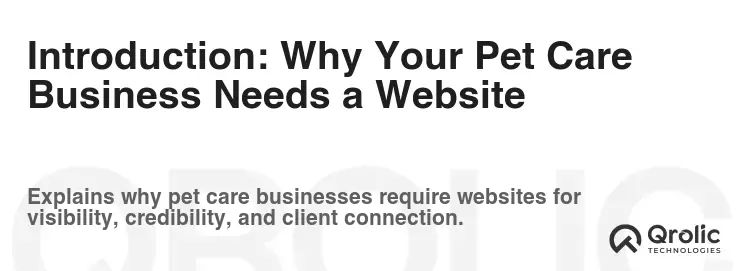
In today’s digital age, a robust online presence is no longer optional; it’s a necessity. This holds especially true for pet care businesses. A website is your digital storefront, a 24/7 advertisement, and a crucial tool for connecting with current and potential clients. Consider this: Where do pet owners turn when they need a dog walker, a pet sitter, or a groomer? The internet, of course! Without a website, you’re missing out on a significant portion of the market and handing opportunities to your competitors.
But a website isn’t just about being present online; it’s about presenting your business in the best possible light. A well-designed, user-friendly pet care website can showcase your services, build trust, establish credibility, and ultimately, drive business growth. This essential guide will walk you through the steps to creating a compelling and effective pet care website that attracts clients and grows your animal service design.
I. Planning Your Pet Care Website: Laying the Foundation for Success

Before you jump into the technical aspects of website creation, careful planning is crucial. This stage involves defining your target audience, identifying your core services, and outlining the overall goals of your website. This meticulous planning will streamline the development process and ensure your website effectively meets your business objectives.
1. Defining Your Target Audience: Who Are You Trying to Reach?
Understanding your target audience is the cornerstone of any successful marketing strategy, including website development. Consider these questions:
- What type of pet owners are you targeting? (e.g., dog owners, cat owners, owners of exotic pets, etc.)
- What is their age range and demographics? (e.g., young professionals, families with children, retirees)
- What are their needs and pain points? (e.g., busy work schedules, travel commitments, special needs pets)
- What services are they most likely to need? (e.g., dog walking, pet sitting, grooming, training)
- What are their online habits and preferences? (e.g., mobile users, social media users, prefer detailed information)
By answering these questions, you can tailor your website’s design, content, and messaging to resonate with your ideal clients. For example, a website targeting young professionals might prioritize online booking and mobile responsiveness, while a website targeting families might focus on safety and security certifications. Understanding your customer is vital to animal service design.
2. Identifying Your Core Services: What Do You Offer?
Clearly define the range of services you offer and their unique benefits. This should go beyond simply listing the services; explain why clients should choose you.
- Dog Walking: Highlight the benefits of exercise for dogs, your experience with different breeds, and the safety protocols you follow.
- Pet Sitting: Emphasize the comfort and convenience of in-home care, your pet-sitting qualifications, and your attention to detail.
- Grooming: Showcase your expertise in breed-specific grooming, the use of high-quality products, and your commitment to pet comfort.
- Pet Training: Describe your training methods, your experience with different behavioral issues, and the positive results you achieve.
- Veterinary Services (if applicable): Highlight your qualifications, specialties, and state-of-the-art facilities.
- Other Services: Include any specialized services you offer, such as pet transportation, pet photography, or pet massage.
Clearly and concisely outlining these services will showcase your company’s expertise for your pet care website.
3. Setting Goals for Your Website: What Do You Want to Achieve?
Define specific, measurable, achievable, relevant, and time-bound (SMART) goals for your website. These goals will guide your website’s design and content, ensuring it effectively contributes to your business objectives.
- Increase Brand Awareness: Expand your online reach and establish your brand as a trusted pet care provider in your local area.
- Generate Leads: Collect contact information from potential clients through online forms, email subscriptions, and appointment requests.
- Drive Bookings: Encourage clients to book your services directly through your website, streamlining the scheduling process.
- Improve Customer Service: Provide clients with easy access to information about your services, policies, and contact details.
- Boost Sales: Increase revenue by promoting special offers, packages, and add-on services through your website.
4. Analyzing Competitor Websites: What Are They Doing Well (and Not So Well)?
Before diving into design and content, take a look at your competitors’ websites. Analyze what they’re doing well – their design aesthetics, service descriptions, user experience – and where they’re falling short. This analysis can provide valuable insights and inspiration for your own website.
- Identify Their Strengths: What aspects of their websites are particularly effective? (e.g., clear navigation, compelling visuals, positive testimonials)
- Identify Their Weaknesses: What areas could they improve? (e.g., outdated information, poor mobile responsiveness, lack of online booking)
- Look for Opportunities: Where can you differentiate yourself and offer something unique that your competitors don’t?
This competitive analysis will help you create a pet care website that stands out from the crowd and effectively attracts clients.
II. Designing Your Pet Care Website: Creating a User-Friendly and Visually Appealing Experience

The design of your website is crucial for attracting and retaining visitors. A well-designed website is visually appealing, easy to navigate, and mobile-friendly. It should also reflect your brand’s personality and values, creating a positive and memorable experience for potential clients.
1. Choosing a Domain Name and Web Hosting: Establishing Your Online Identity
Your domain name is your website’s address on the internet, so choose it carefully. It should be memorable, easy to spell, and relevant to your business.
- Keep it short and simple: Avoid long, complicated domain names that are difficult to remember.
- Use relevant keywords: Include keywords related to your pet care services or your location (e.g., “DogWalkingNYC.com”).
- Choose the right extension: Opt for a common extension like “.com” or “.net.”
- Check availability: Make sure your desired domain name is available before you register it.
Web hosting is the service that stores your website’s files and makes them accessible to visitors. Choose a reliable web hosting provider that offers good uptime, fast loading speeds, and excellent customer support. Some popular options include Bluehost, SiteGround, and HostGator.
2. Selecting a Website Platform: WordPress, Wix, or Other Options?
There are several website platforms to choose from, each with its own advantages and disadvantages.
- WordPress: A popular and versatile platform that offers a wide range of themes and plugins, allowing for customization and flexibility. It’s a good choice if you want full control over your website.
- Wix: A user-friendly platform that offers drag-and-drop functionality, making it easy to create a visually appealing website without coding knowledge.
- Squarespace: Another user-friendly platform that offers stylish templates and built-in e-commerce features.
Consider your technical skills, budget, and desired level of customization when choosing a website platform. WordPress is generally the most powerful and flexible option, while Wix and Squarespace are easier to use for beginners.
3. Choosing a Theme or Template: Creating a Visually Appealing Design
Your website’s theme or template determines its overall look and feel. Choose a theme that is visually appealing, mobile-friendly, and relevant to your pet care business.
- Consider your brand: Choose a theme that reflects your brand’s personality and values.
- Look for a clean and modern design: Avoid cluttered or outdated themes that can detract from the user experience.
- Ensure mobile responsiveness: Make sure the theme is fully responsive and looks good on all devices.
- Check for customization options: Choose a theme that allows you to customize the colors, fonts, and layout to match your brand.
Many free and premium themes are available for popular website platforms like WordPress, Wix, and Squarespace.
4. Designing a User-Friendly Navigation: Making it Easy for Visitors to Find What They Need
Clear and intuitive navigation is essential for a positive user experience. Make it easy for visitors to find the information they need by organizing your website’s content logically and providing clear navigation menus.
- Use a simple and consistent menu structure: Keep the main navigation menu concise and easy to understand.
- Use clear and descriptive labels: Avoid jargon or technical terms that visitors may not understand.
- Provide a search bar: Allow visitors to search for specific information on your website.
- Include a sitemap: Provide a sitemap that lists all the pages on your website, making it easier for search engines to crawl and index your content.
5. Optimizing for Mobile Devices: Reaching Customers on the Go
With the majority of internet users accessing websites on mobile devices, it’s crucial to optimize your website for mobile responsiveness. This means ensuring that your website looks good and functions properly on smartphones and tablets.
- Choose a responsive theme: Select a theme that automatically adjusts to different screen sizes.
- Use a mobile-friendly design: Avoid using large images or complex animations that can slow down loading speeds on mobile devices.
- Optimize images for mobile: Compress images to reduce their file size without sacrificing quality.
- Test your website on different devices: Make sure your website looks and functions properly on a variety of smartphones and tablets.
6. Incorporating High-Quality Images and Videos: Showcasing Your Services
Visual content is essential for attracting and engaging visitors. Use high-quality images and videos to showcase your services and create a positive impression.
- Use professional photos: Invest in professional photography to capture high-quality images of your staff, facilities, and pets.
- Showcase your services: Use images and videos to demonstrate the benefits of your services.
- Use authentic content: Avoid using stock photos that look generic or unnatural.
- Optimize images for web: Compress images to reduce their file size without sacrificing quality.
7. Creating a Consistent Brand Identity: Building Recognition and Trust
Your website should reflect your brand’s personality and values. Use consistent colors, fonts, and imagery to create a cohesive brand identity that resonates with your target audience.
- Develop a brand style guide: Create a style guide that outlines your brand’s colors, fonts, logo, and imagery.
- Use your brand colors and fonts consistently: Apply your brand colors and fonts throughout your website.
- Use your logo prominently: Display your logo in a prominent location on your website.
- Maintain a consistent tone of voice: Use a consistent tone of voice in your website’s content.
III. Creating Compelling Content for Your Pet Care Website: Engaging and Informing Your Audience
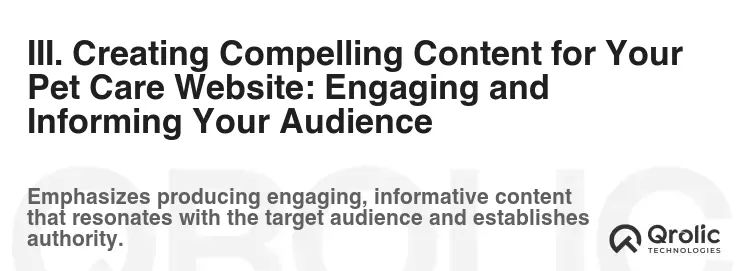
Content is king! Your website’s content is what will attract visitors, engage them, and ultimately, convert them into clients. Focus on creating informative, engaging, and optimized content that resonates with your target audience.
1. Writing Engaging and Informative Service Descriptions: Highlighting the Benefits
Each service you offer should have a dedicated page with a detailed description. Focus on highlighting the benefits of each service and how it can help pet owners.
- Use clear and concise language: Avoid jargon or technical terms that visitors may not understand.
- Focus on the benefits: Explain how each service can improve the pet’s health, happiness, or well-being.
- Use bullet points and headings: Break up long paragraphs of text to make the content easier to read.
- Include testimonials: Showcase positive feedback from satisfied clients.
- Include a call to action: Encourage visitors to book the service or contact you for more information.
2. Creating a Blog: Establishing Authority and Sharing Valuable Information
A blog is a powerful tool for attracting visitors, establishing authority, and sharing valuable information about pet care.
- Write about topics that are relevant to your target audience: Focus on topics that pet owners are interested in, such as pet health, training tips, and breed information.
- Provide valuable and informative content: Offer practical advice and tips that pet owners can use to improve their pet’s life.
- Use keywords strategically: Incorporate relevant keywords into your blog posts to improve their search engine ranking.
- Promote your blog posts on social media: Share your blog posts on social media to reach a wider audience.
- Encourage comments and feedback: Encourage visitors to leave comments and feedback on your blog posts.
3. Adding Testimonials and Reviews: Building Trust and Credibility
Testimonials and reviews are powerful social proof that can help build trust and credibility with potential clients.
- Ask satisfied clients for testimonials: Reach out to satisfied clients and ask them to write a testimonial about their experience.
- Display testimonials prominently on your website: Showcase testimonials on your homepage, service pages, and other relevant pages.
- Use a review platform: Encourage clients to leave reviews on popular review platforms like Google My Business, Yelp, and Facebook.
- Respond to reviews promptly and professionally: Respond to both positive and negative reviews in a timely and professional manner.
4. Including a Contact Form and Contact Information: Making it Easy to Reach You
Make it easy for visitors to contact you by including a contact form and your contact information on your website.
- Include a contact form on your contact page: Make it easy for visitors to send you a message directly from your website.
- Provide your phone number and email address: Make it easy for visitors to contact you by phone or email.
- Include your physical address (if applicable): If you have a physical location, include your address on your website.
- Include your social media links: Link to your social media profiles to allow visitors to connect with you on social media.
- Clearly state your hours of operation: Let customers know your working hours
5. Creating an “About Us” Page: Telling Your Story and Building a Connection
The “About Us” page is an opportunity to tell your story, share your passion for pet care, and build a personal connection with potential clients.
- Share your background and experience: Explain your background in pet care and what motivated you to start your business.
- Highlight your qualifications and certifications: Showcase your qualifications and certifications to demonstrate your expertise.
- Share your mission and values: Explain your mission and values and how they guide your business practices.
- Include photos of your staff and facilities: Use photos to create a personal connection and showcase your facilities.
- Write in a conversational tone: Use a friendly and approachable tone to connect with visitors.
IV. Optimizing Your Pet Care Website for Search Engines (SEO): Getting Found Online
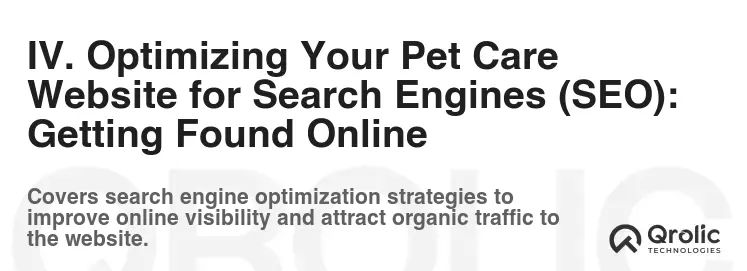
Search engine optimization (SEO) is the process of optimizing your website to rank higher in search engine results pages (SERPs). This is crucial for attracting organic traffic and reaching potential clients who are searching for pet care services online.
1. Keyword Research: Identifying the Right Terms to Target
Keyword research is the process of identifying the keywords and phrases that your target audience is using to search for pet care services online.
- Use keyword research tools: Use tools like Google Keyword Planner, Ahrefs, and SEMrush to identify relevant keywords.
- Focus on long-tail keywords: Target long-tail keywords (longer, more specific phrases) to attract a more targeted audience.
- Analyze your competitors’ keywords: Identify the keywords that your competitors are targeting.
- Consider local keywords: Target local keywords (e.g., “dog walker in New York City”) to attract local clients.
2. On-Page Optimization: Optimizing Your Website’s Content and Structure
On-page optimization involves optimizing your website’s content and structure to improve its search engine ranking.
- Use keywords strategically: Incorporate relevant keywords into your website’s title tags, meta descriptions, headings, and content.
- Optimize your website’s structure: Use a clear and logical website structure to make it easy for search engines to crawl and index your content.
- Optimize your images: Use descriptive file names and alt tags for your images.
- Improve your website’s loading speed: Optimize your website’s loading speed to improve user experience and search engine ranking.
- Use internal linking: Link to other relevant pages on your website to improve its search engine ranking.
3. Off-Page Optimization: Building Authority and Backlinks
Off-page optimization involves building authority and backlinks to your website from other reputable websites.
- Build backlinks from relevant websites: Earn backlinks from other websites in the pet care industry or local business directories.
- Participate in social media: Engage with your audience on social media and share your website’s content.
- Get listed in online directories: List your business in online directories like Yelp, Google My Business, and Yellow Pages.
- Write guest posts for other websites: Write guest posts for other websites in the pet care industry to earn backlinks and exposure.
- Monitor your website’s ranking: Track your website’s ranking in search engine results pages and make adjustments as needed.
4. Local SEO: Optimizing for Local Searches
Local SEO is crucial for attracting local clients who are searching for pet care services in your area.
- Claim your Google My Business listing: Claim and optimize your Google My Business listing to improve your visibility in local search results.
- Get listed in local directories: List your business in local directories like Yelp, Citysearch, and Foursquare.
- Encourage clients to leave reviews on Google My Business: Encourage clients to leave reviews on your Google My Business listing to improve your local search ranking.
- Use local keywords: Incorporate local keywords into your website’s content and meta descriptions.
- Optimize your website for mobile: Ensure that your website is mobile-friendly to reach local clients who are searching on their smartphones.
V. Promoting Your Pet Care Website: Reaching a Wider Audience

Once your website is live, it’s important to promote it to reach a wider audience and attract potential clients.
1. Social Media Marketing: Engaging with Pet Owners Online
Social media is a powerful tool for engaging with pet owners online, building brand awareness, and driving traffic to your website.
- Choose the right social media platforms: Focus on the platforms that your target audience is using, such as Facebook, Instagram, and Twitter.
- Create engaging content: Share interesting and informative content that resonates with pet owners.
- Run social media contests and giveaways: Use contests and giveaways to attract new followers and engage with your audience.
- Use social media advertising: Use social media advertising to reach a wider audience and target specific demographics.
- Monitor your social media performance: Track your social media performance and make adjustments as needed.
2. Email Marketing: Nurturing Leads and Staying in Touch
Email marketing is an effective way to nurture leads, stay in touch with existing clients, and promote your services.
- Build an email list: Collect email addresses from visitors to your website and social media followers.
- Segment your email list: Segment your email list based on demographics, interests, or service preferences.
- Create engaging email content: Send informative and valuable content to your email subscribers.
- Promote your services in your emails: Promote your services and special offers in your emails.
- Track your email marketing performance: Track your email marketing performance and make adjustments as needed.
3. Online Advertising: Reaching a Targeted Audience
Online advertising can be an effective way to reach a targeted audience and drive traffic to your website.
- Use Google Ads: Use Google Ads to target potential clients who are searching for pet care services online.
- Use social media advertising: Use social media advertising to reach a wider audience and target specific demographics.
- Use retargeting advertising: Use retargeting advertising to target visitors who have previously visited your website.
- Track your online advertising performance: Track your online advertising performance and make adjustments as needed.
4. Local Partnerships: Collaborating with Other Businesses
Partnering with other local businesses can be a great way to reach a wider audience and promote your pet care website.
- Partner with local pet stores: Offer discounts or promotions to customers of local pet stores.
- Partner with local veterinary clinics: Offer discounts or promotions to clients of local veterinary clinics.
- Partner with local dog walkers or pet sitters: Cross-promote each other’s services.
- Participate in local events: Attend local events and promote your pet care business.
VI. Maintaining and Updating Your Pet Care Website: Ensuring Long-Term Success
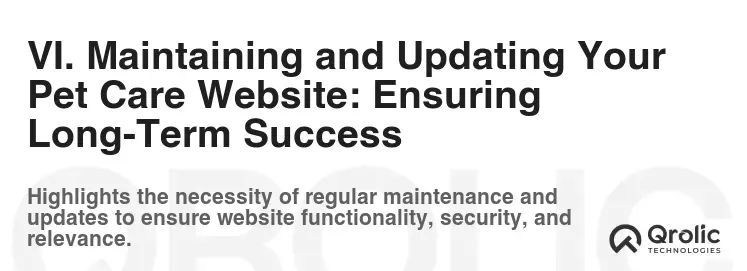
Creating a website is just the first step. To ensure its long-term success, you need to maintain and update it regularly.
1. Regularly Updating Content: Keeping Your Website Fresh and Relevant
Regularly updating your website’s content is crucial for keeping it fresh and relevant in the eyes of both visitors and search engines.
- Update your service descriptions: Keep your service descriptions up-to-date and accurate.
- Add new blog posts: Regularly add new blog posts to keep your website fresh and informative.
- Update your testimonials and reviews: Add new testimonials and reviews to keep your website current and trustworthy.
- Update your “About Us” page: Keep your “About Us” page up-to-date with your latest accomplishments and team members.
- Check for broken links: Regularly check for broken links and fix them promptly.
2. Monitoring Website Performance: Tracking Key Metrics
Monitoring your website’s performance is essential for identifying areas for improvement and ensuring that your website is meeting your goals.
- Use Google Analytics: Use Google Analytics to track key metrics such as website traffic, bounce rate, and conversion rate.
- Track your search engine ranking: Track your website’s ranking in search engine results pages.
- Monitor your social media performance: Track your social media performance and make adjustments as needed.
- Monitor your email marketing performance: Track your email marketing performance and make adjustments as needed.
- Use Website Speed testing tools: Ensure your website is loading quickly and efficiently.
3. Backing Up Your Website: Protecting Your Data
Backing up your website regularly is crucial for protecting your data in case of a disaster.
- Use a website backup plugin: Use a website backup plugin to automatically back up your website’s files and database.
- Store your backups in a safe place: Store your backups in a safe place, such as a cloud storage service or an external hard drive.
- Test your backups: Regularly test your backups to ensure that they are working properly.
4. Ensuring Security: Protecting Your Website from Threats
Ensuring the security of your website is crucial for protecting it from hackers and malware.
- Use a strong password: Use a strong password for your website’s administrator account.
- Keep your website software up-to-date: Regularly update your website’s software to patch security vulnerabilities.
- Use a security plugin: Use a security plugin to protect your website from common threats.
- Use an SSL certificate: Use an SSL certificate to encrypt the data that is transmitted between your website and visitors.
VII. Seeking Professional Assistance: When to Hire Experts

While this guide provides a comprehensive overview of creating a pet care website, there may be times when you need to seek professional assistance.
- Website Design: If you lack the design skills to create a visually appealing and user-friendly website, consider hiring a professional website designer.
- Website Development: If you lack the technical skills to build a complex website with advanced features, consider hiring a website developer.
- SEO: If you lack the expertise to optimize your website for search engines, consider hiring an SEO expert.
- Content Creation: If you lack the time or writing skills to create engaging and informative content, consider hiring a content writer.
- Marketing: If you lack the marketing expertise to promote your website effectively, consider hiring a marketing agency.
VIII. Qrolic Technologies: Your Partner in Digital Success

Creating a successful pet care website involves a multifaceted approach, combining thoughtful animal service design with effective marketing strategies. At Qrolic Technologies (https://qrolic.com/), we understand the unique challenges and opportunities within the pet care industry. We offer a comprehensive suite of digital services designed to help your business thrive online. From website development and design to SEO, content marketing, and social media management, we provide the expertise and support you need to attract new clients, build brand loyalty, and grow your business. Our team of experienced professionals will work closely with you to develop a customized strategy that aligns with your specific goals and budget. Contact us today to learn more about how Qrolic Technologies can help you achieve digital success!
Conclusion: Your Path to Online Success in Pet Care
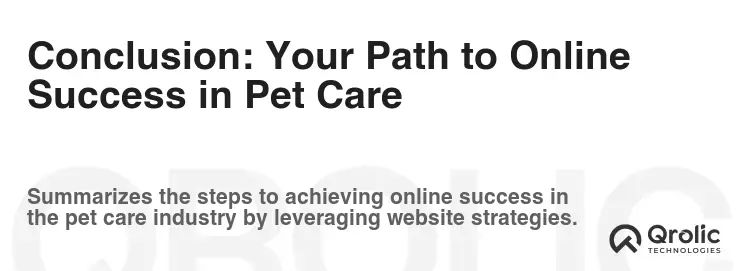
Creating a successful pet care website is an ongoing process that requires planning, design, content creation, SEO, promotion, and maintenance. By following the steps outlined in this essential guide, you can create a website that effectively attracts clients, builds trust, establishes credibility, and drives business growth. Remember to focus on providing a user-friendly experience, creating engaging content, and optimizing your website for search engines. With dedication and a strategic approach, you can achieve online success in the competitive pet care industry and realize your vision for the animal service design. Good luck!
